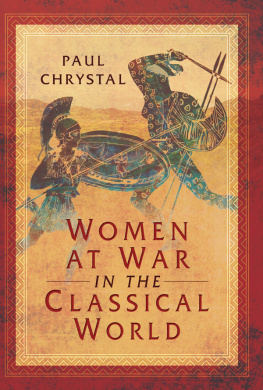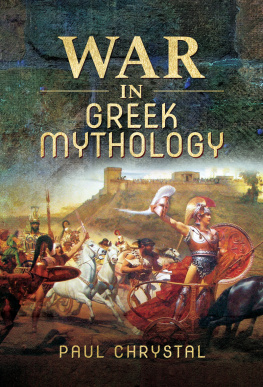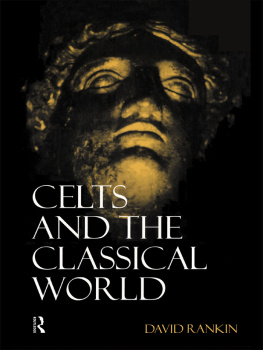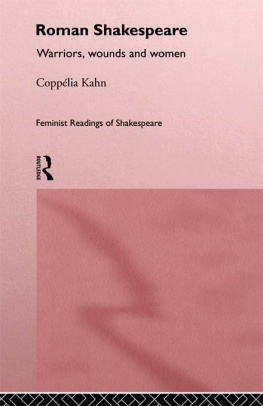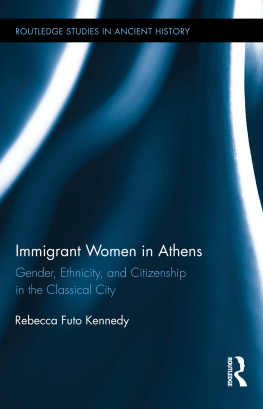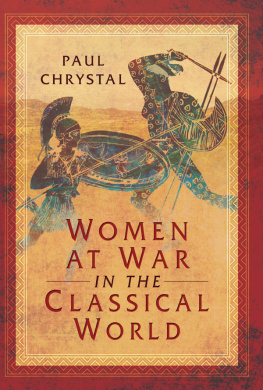
Women at War in the Classical World
Dedication
For the women and girls inside Syria and those who have fled the conflict for safety in Lebanon, Jordan, Turkey and Iraq. Many have been subject to sexual and gender-based violence, coerced into early marriages, overwhelmed by economic strife, and psychologically scarred by loss in a war that seemingly has no end. Women and girls affected by conflict must be regarded as more than victims of brutality; they are agents of change who, if given the opportunity, can transform their societies.
Ambassador Melanne Verveer
Executive Director
Georgetown Institute for Women, Peace and Security
https://www.rescue.org/sites/default/files/resource-file/IRC_WomenInSyria_Report_WEB.pdf
Women at War in the Classical World
Paul Chrystal
First published in Great Britain in 2017 by
PEN & SWORD MILITARY
An imprint of
Pen & Sword Books Ltd
47 Church Street
Barnsley
South Yorkshire
S70 2AS
Copyright Paul Chrystal, 2017
ISBN 978-1-47385-660-8
eISBN: 978-1-47385-661-5
Mobi ISBN: 978-1-47385-662-2
The right of Paul Chrystal to be identified as the author of this work has been asserted by him in accordance with the Copyright, Designs and Patents Act 1988.
A CIP catalogue record for this book is available from the British Library.
All rights reserved. No part of this book may be reproduced or transmitted in any form or by any means, electronic or mechanical including photocopying, recording or by any information storage and retrieval system, without permission from the Publisher in writing.
Pen & Sword Books Ltd incorporates the imprints of Pen & Sword Archaeology, Atlas, Aviation, Battleground, Discovery, Family History, History, Maritime, Military, Naval, Politics, Railways, Select, Social History, Transport, True Crime, and Claymore Press, Frontline Books, Leo Cooper, Praetorian Press, Remember When, Seaforth Publishing and Wharncliffe.
For a complete list of Pen & Sword titles please contact
PEN & SWORD BOOKS LIMITED
47 Church Street, Barnsley, South Yorkshire, S70 2AS, England
E-mail:
Website: www.pen-and-sword.co.uk
List of Plates
The skeleton of a young woman from Cemetery 2, Kurgan 8, Burial 4 at Pokrova, Russia.
Andromache, Astyanax and Hector in a touching scene from the Iliad, Apulian red-figure column-crater, c. 370360 BCE .
Menelaus goes to strike Helen, but stunned by her beauty, he drops his sword, detail of an Attic red-figure crater, c. 450440 BCE .
A scene showing Achilles fighting with the Amazon Penthesilea; on a sarcophagus dated c. 250 CE .
Papyrus fragment with a drawing of the abduction of Briseis by Talthybius and Eurybates in the Iliad (Book 1, lines 33048), fourth century BCE .
Amazonomachy marble, sarcophagus panel, c . 16070 CE .
Amazon mosaic from Paphos found in the Orpheus House, 3rd century CE .
Amazonomachy scene on a lekythos, c. 420 BCE .
Jacques-Louis David (17481825), The Intervention of the Sabine Women, 1799.
Jean Jacques Franois Lebarbier, A Spartan Woman Giving a Shield to Her Son, 1805. ( The Portland Art Museum, Ohio)
The rampart walk on the East Wall in Jerusalem with the Dome of the Rock in the background. (Thanks to Professor Tod Bolen at Bibleplaces.com, Santa Clarita, CA)
Woodcut illustration of Veturia and Volumnia confronting Coriolanus, from an incunable German translation by Heinrich Steinhwel of Giovanni Boccaccios De mulieribus claris, c. 1474.
A detail from the frieze of the Basilica Aemilia depicting the punishment of Tarpeia, c. 14 BCE .
Vincenzo Camuccini, Roman Women Offering their Jewellery in Defence of the State, c. 1825. ( Glasgow Museums)
Paul Jamin, Brennus et sa part de butin Brennus and his Share of the Spoils, 1873.
Statue of a mourning barbarian woman, a victim of war, which stands in the Loggia dei Lanzi, Florence.
The terrible scene that is the end of the Roman Empire, with women pursued in the chaos Thomas Cole, The Course of Empire 4: Destruction (1836). (Thanks to The Schiller Inc, Washington DC, http://www.theathenaeum.org/art/list.php?m=a&s=du&aid=375 )
Pavel Svedonsky (18491904), Fulvia with the Head of Cicero.
Agrippina I on the Rhine fortifications. (Thanks to Jasper Burns for permission to use this, originally published in his Great Women of Imperial Rome )
Peter Froste (b.1935), The Temple of Claudius in Camelodunum, going up in flames at the hands of Boudica in 60 CE . (Courtesy of Colchester and Ipswich Museum Service)
A detail from the Column of Marcus Aurelius showing captured women and children.
Woodcut illustration showing Artemisia II of Caria drinking the ashes of her husband Mausolus, from an incunable German translation by Heinrich Steinhwel of Giovanni Boccaccios De mulieribus claris, c. 1474.
Marble relief from Halicarnassus showing two female gladiators fighting, first or second century CE .
Acknowledgements
My thanks to Professor Amy C. Smith at the Ure Museum of Greek Archaeology in the Department of Classics, University of Reading for permission to use a number of their images.
Abbreviations
| AC | LAntiquite Classique |
| AJAH | Americal Journal of Ancient History |
| AJPh | American Journal of Philology |
| AncW | Ancient World |
| AZ | Archaeologische Zeitung (Berlin, 1848) |
| CEG | P.A. Hansen, Carmina Epigraphica Graeca (Berlin, 1983) |
| CJ | Classical Journal |
| CIG | Corpus Inscriptionum Graecarum (Berlin, 182577) |
| CIL | Corpus Inscriptionum Latinarum, (Berlin, 1863) |
| CP | Classical Philology |
| CQ | Classical Quarterly |
| CW | Classical World |
| EMC | Echos du Monde Classique |
| FGrH | F. Jacoby, Die Fragmente der Griechischen Historiker (Leiden, 192357) |
| G&R | Greece and Rome |
| GRBS | Greek, Roman and Byzantine Studies |
| HN | Pliny the Elder, Historia Naturalis |
| HSCP | Harvard Studies in Classical Philology |
| IG | Inscriptiones Graecae |
| JRS | Journal of Roman Studies |
| P. Oxy | The Oxyrhynchus Papyrus |
| PCG | Poetae Comici Graici |
| PMG | Poetae Melici Graeci (Oxford, 1962) |
| RhM | Rheinisches Museum fur Philologie |
| SO | Symbolae Osloensis |
| TAPA | Transactions of the Proceedings of the American Philological Association |
| WS | Wiener Studien |
Introduction
This is the first single-author book to address and analyse the role of women in classical warfare both as agents of and participants in war, and as victims of war. It is often assumed, beginning with Hectors remarks in the Iliad, that conflict was the exclusive preserve of men in the battles and wars fought by the ancient Greeks and the Romans. After all, Alexander the Great, Scipio Africanus and Julius Caesar are much more familiar than, for example, Fulvia who embroiled herself in the conflicts of Mark Antony, her husband, during the Perusine War, or Agrippina the Elder who got involved with the troubled legions in Germanicus campaigns in Germania. At least Cleopatra and Boudica are much better known. These military women are just four of many who took on exceptional and significant roles in the wars of the ancient Greeks and Romans from Homer to the end of the Roman Empire: in those 1,200 or so years there is a large number of women who had a role in the causation, direction or conduct of wars and battles. Guile, military intelligence, diplomacy, tactical excellence, courage and ferocity are just a few of the qualities exhibited by the women featured here. This may still surprise some readers today, but, when we observe that many of the books and journals published in recent years on Greek and Roman warfare ignores the role of women, then I remain unsuprised that they are surprised.
Next page
